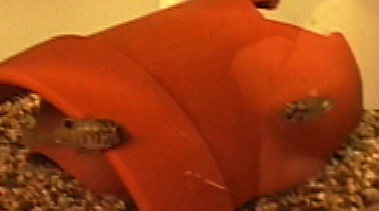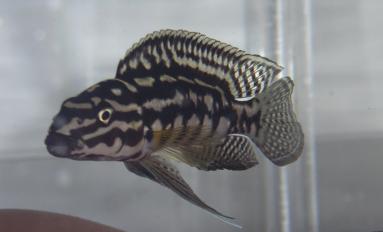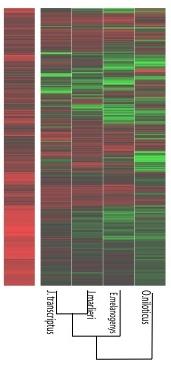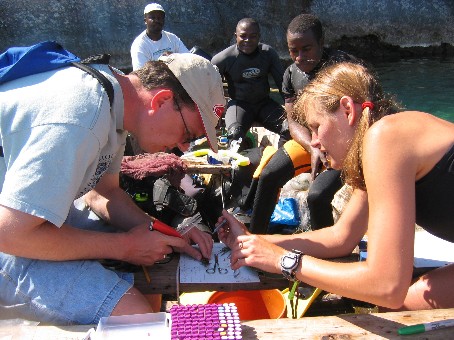Department of Biology
Renn Lab
Fish 'N Chips: Comparative Genomics and the Evolution of Behavior in African Cichlid Fishes.
Research Interests
Come visit my lab and I will tell you about our diverse research interests.
I work in both the field and the lab in order to study the evolution of genomes and the evolution of behavior. We use modern genomic techniques in a comparative approach.
The Evolution of Genomes
We explore the genomic architecture of adaptive radiation, particularly with regard to gene duplication, a process long thought to be a major source of evolutionary novelty. The African cichlid radiations provide an exceptional model with which to uncover the genetic basis not only of adaptive radiation, but of the rapid phenotypic divergence and speciation characteristic of these radiations. Importantly, several of the radiated lineages possesses a close relative that has not undergone radiation.
We use array-based comparative genomic hybridization (aCGH) to quantify gene duplication and gene sequence divergence in cichlid lineages hat have and have not undergone rapid speciation. Thus far our results reveal shared duplications among 3 Lake Malawi drainage species (Metriaclima estherae, Protomelas similis, Rhamphochromis “chilingali”) from radiated lineages, and a 38% – 49% increase relative to the total number identified in a related species from a non-radiated lineage (Astatotilapia tweddlei).
We have perfomred an extensive proof of concept for this technique by taking advantage of Drosophilid species for which full genome sequence exists.
The Evolution of Behavior
Molecular modules of aggression; maternal behavior in the African cichlid Astatotilapia burtoni Abstract funded by NSF BIO-Neural Systems.
While aggressive, territorial, socially regulated dominance behavior in the males of this species has been a long standing and fruitful model for the mechanistic study of mechanisms underlying complex behavior, few studies have investigated female behavior. This is, in part, due to the fact that the labstock females, collected in 1977 do not show many interesting social behaviors. However, a recently collected wild stock of this same species exhibits a rich repertoire of aggressive and maternal behaviors. I aim to use this model to uncover molecular, hormonal and genetic mechanisms responsible for these behaviors and the differences between the two stocks.
Mechanisms for Environmental and Genetic Reversal of Gender Biased Beahvior Project Description funded by NIH - NIGMS through the R15 AREA program.
The great influence of sex on the brain is undeniable at the level of neuroanatomy, neurochemistry, brain function, and even behavior. The proposed systems level research integrates data from behavioral, physiological and molecular level in order to contrast mechanisms by which genes and the environment influence gender-biased behaviors and identify neuroanatomical sites important for the regulation of these behaviors. I use an animal model (cichlid fish) to study complex social behaviors that are directly relevant to the broad range of normal sex-related differences in human social behaviors as well as psychiatric conditions that show both genetic and environmental components. We rely primarily upon two species of the genus Julidochromis, one that exhibits conventional sex-role behavior and one that exhibits characteristics of s
ex-role reversal. Furthermore, by manipulating the relative size ratio between males and females these species can be induced to switch gender biased behaviors. This allows us to investigate the molecular and hormonal mechanism that orchestate these behaviors.
Past Research (still continued)
Natural Sex-role reversal among species of the genus Julidochromis: behavior, and ecology. (proposal funded in part by A.C.A.)
Molecular basis of socially regulated male aggressive behavior in the established A. burtoni model species. (video excerpt from The Body Changers; National Geographic) -- Manuscript in press --
Molecular basis of experimentally induced sex-role
behavior in females
of the established A. burtoni model species. (recent poster) -- Manuscript
in Prep
-- In collaboration with Eleanor Fraser (Harvard student, senior
thesis)
hCGH technique proof of principle using several sequenced
species of Drosophila in order to understand the relationship between
hybridization ratio and characteristics of genomic divergence. -- Manuscript
in Prep
-- In collaboration with Rob
Kulathinal (Fly Base)
Molecular mechanisms of genetic (natural) and environmental
(temperature) sex differentiation in the aquaculture tilapia
cichlid species. (J.E.B.
funded proposal t o H. Lequang) -- Manuscript in Prep
-- In collaboration with Hao Lequang, Helena D'Cotta and JF Baroiller
(CIRAD)
Sex Determination in African Cichlids: Genetic, or Environmental (social
regulation) ?
-- In collaboration with Jasmine Christell Dowell (Harvard Student, HCRP
project)
Acknowledgements:
I am grateful for the support of my former advisor and current collaborator Hans Hofmann as well as other members of that lab, Nadia Aubin-Horth, Daphne Soares, Nina Duftner, Jonah Larkins-Ford, as well as the students who worked in the lab. These projects have been funded by Reed College, NSF, NIH, WISC, ACA, JEB and the Bauer Center.





